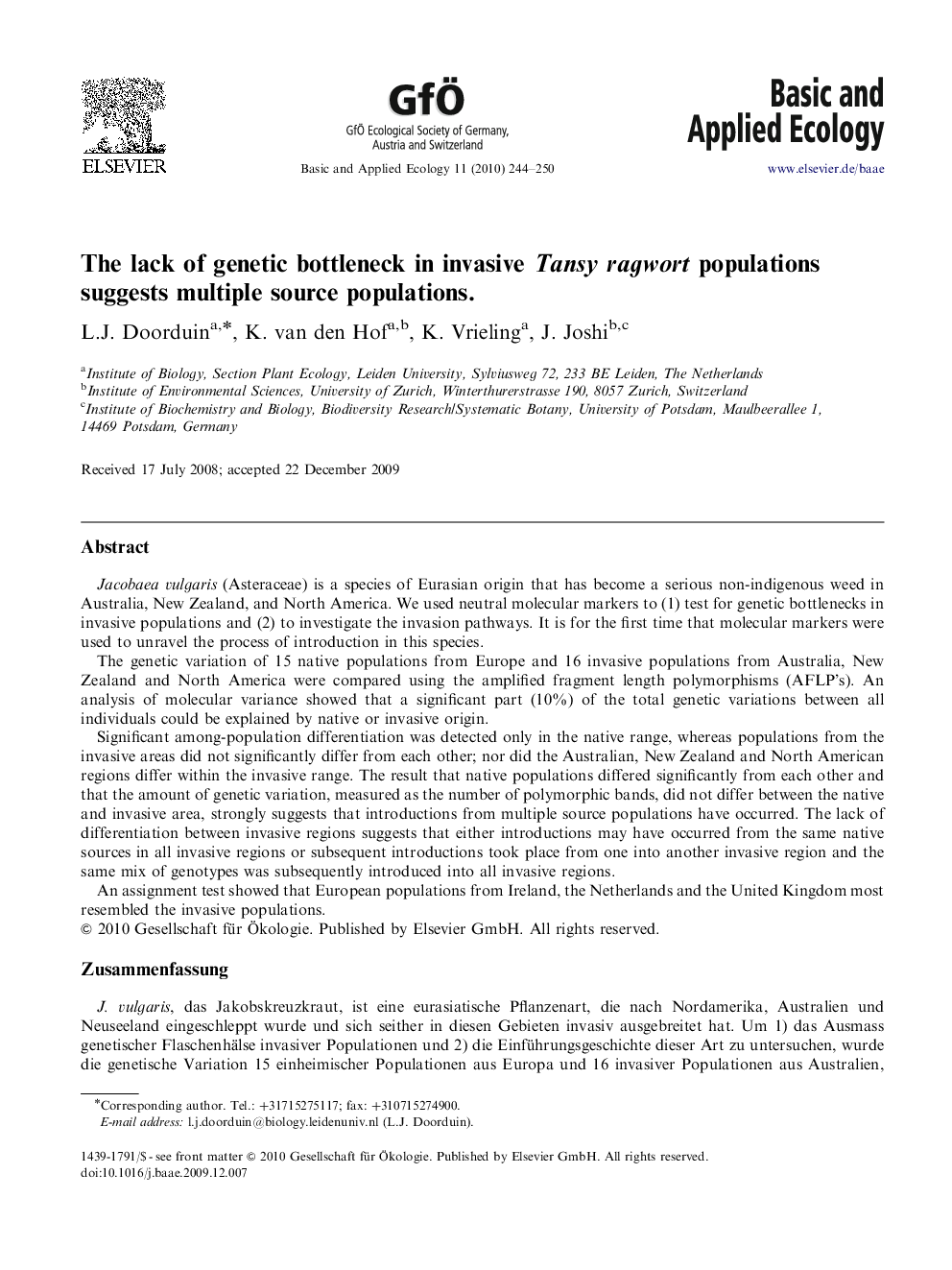| Article ID | Journal | Published Year | Pages | File Type |
|---|---|---|---|---|
| 4384658 | Basic and Applied Ecology | 2010 | 7 Pages |
Jacobaea vulgaris (Asteraceae) is a species of Eurasian origin that has become a serious non-indigenous weed in Australia, New Zealand, and North America. We used neutral molecular markers to (1) test for genetic bottlenecks in invasive populations and (2) to investigate the invasion pathways. It is for the first time that molecular markers were used to unravel the process of introduction in this species.The genetic variation of 15 native populations from Europe and 16 invasive populations from Australia, New Zealand and North America were compared using the amplified fragment length polymorphisms (AFLP's). An analysis of molecular variance showed that a significant part (10%) of the total genetic variations between all individuals could be explained by native or invasive origin.Significant among-population differentiation was detected only in the native range, whereas populations from the invasive areas did not significantly differ from each other; nor did the Australian, New Zealand and North American regions differ within the invasive range. The result that native populations differed significantly from each other and that the amount of genetic variation, measured as the number of polymorphic bands, did not differ between the native and invasive area, strongly suggests that introductions from multiple source populations have occurred. The lack of differentiation between invasive regions suggests that either introductions may have occurred from the same native sources in all invasive regions or subsequent introductions took place from one into another invasive region and the same mix of genotypes was subsequently introduced into all invasive regions.An assignment test showed that European populations from Ireland, the Netherlands and the United Kingdom most resembled the invasive populations.
ZusammenfassungJ. vulgaris, das Jakobskreuzkraut, ist eine eurasiatische Pflanzenart, die nach Nordamerika, Australien und Neuseeland eingeschleppt wurde und sich seither in diesen Gebieten invasiv ausgebreitet hat. Um 1) das Ausmass genetischer Flaschenhälse invasiver Populationen und 2) die Einführungsgeschichte dieser Art zu untersuchen, wurde die genetische Variation 15 einheimischer Populationen aus Europa und 16 invasiver Populationen aus Australien, Neuseeland und Nordamerika mittels neutraler molekularer Marker (AFLP's), die noch nie für die Untersuchung der Einführungsgeschichte dieser Art verwendet wurden, analysiert.Eine Analyse der molekularen Varianz zeigte, dass ein signifikanter Anteil (10%) der gesamten genetischen Variation zwischen allen Individuen auf Unterschiede zwischen Ursprungs- und Invasionsgebiet zurückzuführen ist. Signifikante genetische Differenzierung zwischen Populationen wurde nur im europäischen Ursprungsgebiet gefunden, während sich die Populationen im Invasionsgebiet und auch die Regionen innerhalb des Invasionsgebiets (Australien, Neuseeland und Nordamerika) genetisch nicht signifikant voneinander unterschieden. Die signifikante genetische Differenzierung zwischen einheimischen, europäischen Populationen und das Fehlen von Unterschieden in genetischer Variation, gemessen als Anzahl polymorpher Banden, zwischen Ursprungs- und Invasionsgebiet weist darauf hin, dass J. vulgaris aus verschiedenen Ursprungspopulationen eingeschleppt wurde. Die fehlende Differenzierung zwischen Regionen innerhalb des Invasionsgebiets könnte darauf zurückzuführen sein, dass entweder Populationen aus denselben Ursprungsgebieten in das ganze Invasionsgebiet eingeschleppt wurden oder, dass Einschleppungen von einem Invasionsgebiet ins andere stattfanden. Ein Assignment-test weist auf europäische Populationen aus Irland, Großbritannien und den Niederlanden als wahrscheinlichste Ursprungsregionen hin.
